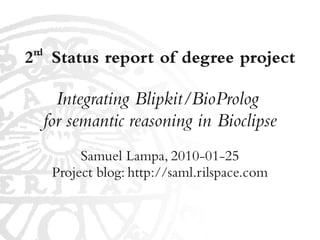
2nd Proj. Update: Integrating SWI-Prolog for Semantic Reasoning in Bioclipse
- 1. nd 2 Status report of degree project Integrating Blipkit/BioProlog for semantic reasoning in Bioclipse Samuel Lampa, 2010-01-25 Project blog: http://saml.rilspace.com
- 3. What is “Semantic Web”?
- 4. What is Semantic Web? “Enabling more powerful use of information” Main goals: ● Data availability (on the web) ● Machine-readability of data ● Knowledge integration ● Automatic “conclusion drawing” ● “Reasoning”, using Reasoners →
- 5. This project compares two reasoners: Pellet and Blipkit
- 7. Research question How do biochemical questions formulated as Prolog queries compare to other solutions available in Bioclipse in terms of speed and expressiveness?
- 8. Semantic Reasoners ● Pellet/Jena ● Uses W3C languages – OWL (Class definitions) – RDF (Facts) – SPARQL (Querying) ● Blipkit/BioProlog ● Uses Prolog, with W3C languages “on top” – Class definitions, Facts and Queries either in W3C languages (“on top” of prolog) or in pure Prolog!
- 10. What is Prolog? ● State facts and rules ● Execute by running queries over these facts and rules ● Unique features: ● Backtracking ● “Closed-world assumption”
- 12. Prolog code example % === SOME FACTS === hasHBondDonors( substanceX, 3 ). % “substance X has 3 H-bond donors” % etc … % === A RULE ("RULE OF FIVE" ÀLA PROLOG) === isDrugLike( Substance ) :- hasHBondDonorsCount( Substance, HBDonors ), HBDonors <= 5, hasHBondAcceptorsCount( Substance, HBAcceptors ), HBAcceptors <= 10, hasMolecularWeight( Substance, MW ), MW < 500. % === QUERYING THE RULE === ?- isDrugLike(substanceX) true. ?- isDrugLike(X) X = substanceX ; X = substanceY.
- 13. Prolog code example % === SOME FACTS === hasHBondDonors( substanceX, 3 ). % “substance X has 3 H-bond donors” % etc … % === A RULE ("RULE OF FIVE" ÀLA PROLOG) === Head Implication (“If [body] then [head]”) isDrugLike( Substance ) :- hasHBondDonorsCount( Substance, HBDonors ), HBDonors <= 5, hasHBondAcceptorsCount( Substance, HBAcceptors ), HBAcceptors <= 10, hasMolecularWeight( Substance, MW ), MW < 500. Body % === QUERYING THE RULE === ?- isDrugLike(substanceX) Comma means conjunction (“and”) true. ?- isDrugLike(X) X = substanceX ; X = substanceY. Capitalized terms are always variables
- 14. Prolog code example % === SOME FACTS === hasHBondDonors( substanceX, 3 ). % “substance X has 3 H-bond donors” % etc … % === A RULE ("RULE OF FIVE" ÀLA PROLOG) === isDrugLike( Substance ) :- hasHBondDonorsCount( Substance, HBDonors ), HBDonors <= 5, hasHBondAcceptorsCount( Substance, HBAcceptors ), HBAcceptors <= 10, hasMolecularWeight( Substance, MW ), MW < 500. % === QUERYING THE RULE === ?- isDrugLike(substanceX) Testing a specific atom (“sutstanceX”) true. ?- isDrugLike(X) X = substanceX ; By submitting a variable (“X”), it will be populated with all instances which satisfies the “isDrugLike” rule X = substanceY.
- 15. Where are we now?
- 16. Project plan
- 17. What is done so far?
- 18. What is done so far? ● Integration of Blipkit in Bioclipse ● Done: General purpose methods ● Done: Found usage strategy for combined use of Bioclipse JS scripting and Prolog ● Comparing Prolog and Pellet ● Done: Simple performance testing ● Now: Stuck on NMR spectrum similarity search – (No backtracking on arithmetic operators in SPARQL)
- 19. What is left?
- 20. What remains to be done? ● Integration of Prolog / Blipkit ● Refinements? ● Comparing Prolog and Pellet ● NMR spectrum similarity search – Investigate use of OWL in querying – Other options? SWRL? ● ChEMBL data ● Toxicity data (opentox.org)
- 21. Example Bioclipse / Prolog script
- 22. Example Bioclipse/Prolog script blipkit.init(); blipkit.loadRDFToProlog("nmrshiftdata.100.rdf.xml"); // Define a “convenience prolog method” blipkit.loadPrologCode(" hasPeak( Subject, Predicate ) :- rdf_db:rdf( Subject, 'http://www.nmrshiftdb.org/onto#hasPeak', Predicate ). "); // Call the convenience method (which in turn executes it's // “body”), and returns all mathing results as an array var resultList = blipkit.queryProlog(["hasPeak","10","Subject","Predicate"]);
- 23. Example Bioclipse/Prolog script blipkit.init(); blipkit.loadRDFToProlog("nmrshiftdata.100.rdf.xml"); // Define a “convenience prolog method” blipkit.loadPrologCode(" hasPeak( Subject, Predicate ) :- rdf_db:rdf( Subject, 'http://www.nmrshiftdb.org/onto#hasPeak', Predicate ). "); Prolog rule to load into prolog engine // Call the convenience method (which in turn executes it's // “body”), and returns all mathing results as an array var resultList = blipkit.queryProlog(["hasPeak","10","Subject","Predicate"]); Prolog method to call Limit the number of results Prolog variables
- 24. Current status of research question
- 25. Current status of research question ● Performance ● Prolog won so far. Exceptions? ● Usability ● Prolog very convenient for iterative wrapping of complex logic. Can RDF/OWL/SPARQL replicate this? ● Where do RDF/OWL/SPARQL excel?
- 26. Project plan
- 27. Thank you! Project blog: http://saml.rilspace.com
- 28. Project plan – Current version
- 29. Project plan – Proposed version
